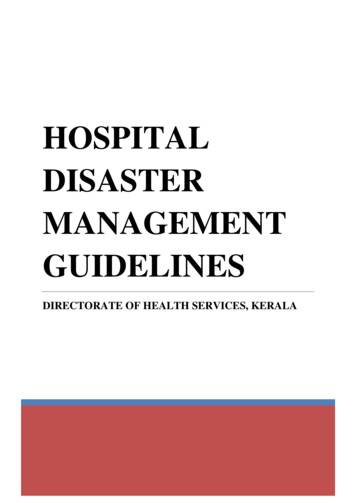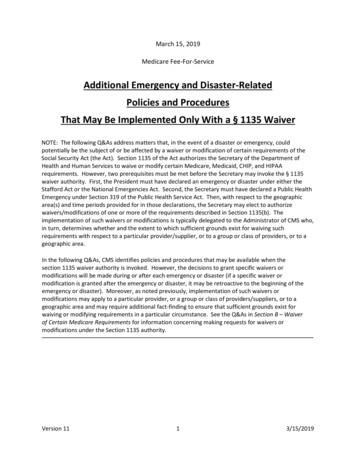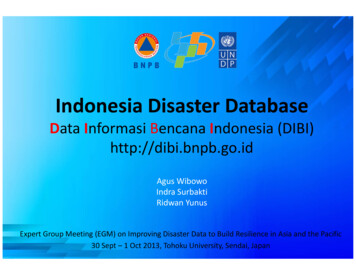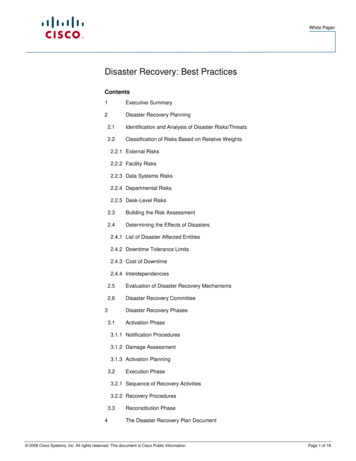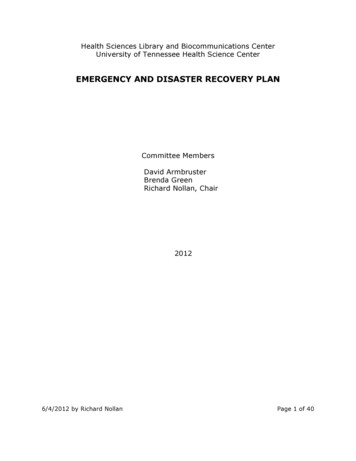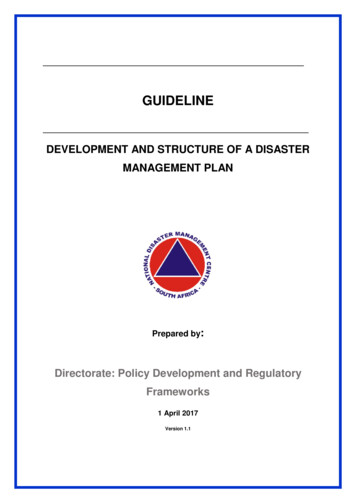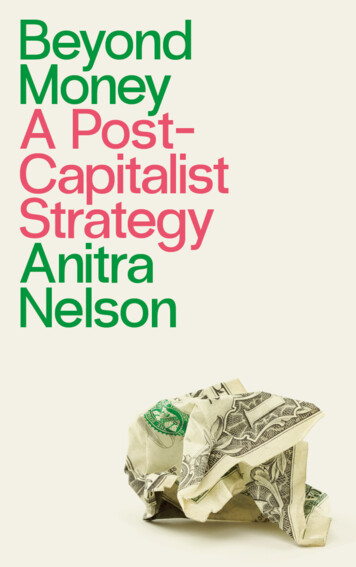
Transcription
Disaster Anarchy
‘Commendable. Firth complicates the important concept of mutual aid, examining thedanger of neoliberal recuperation while emphasising the subversive possibilities at itsheart. She also brings to bear pithy critiques of both the liberal, mainstream practicearound “natural disasters” and the ultimately demobilising, snarky-but-useless leftisttakes that whether myopically or cynically conflate or confuse revolutionary practicesof decentralisation and self-organisation with neoliberal practices of austerity andatomisation. The result is a book that prepares us to think about and react to the kindsof system failures, collapses, and other disasters that will become increasingly morecommon over the next decades.’—Peter Gelderloos, activist and author of The Solutions Are Already Here:Strategies for Ecological Revolution From Below‘Supremely accomplished. Disaster Anarchy is a major step forward in the theoryof anarchist practice and deserves our urgent attention as the collapse of capitalismunfolds.’—Uri Gordon, author of Anarchy Alive!‘Disaster Anarchy is a clear, timely and rigorous account of anarchist responses tocatastrophes. It avoids romanticisation, as Rhiannon Firth incisively unpicks state/corporate strategies of co-option. Nevertheless, Rhiannon’s research also provides aninspiring record of achievement by mutual aid radicals.’—Benjamin Franks, Senior Lecturer in Social and Political Philosophy,University of Glasgow‘This book disrupts disaster studies using an anarchist epistemology to question widelyheld assumptions about the state, businesses and social capital in recovery. Drawing ona range of critical theories and empirical data, Firth finds anarchist practices underlieeveryday actions in “fast” and “slow” disasters. Anarchism is often absent as a politicaland prefigurative theory in crisis and disaster. This ground-breaking book shows howimagination, radical pedagogy, and social movements are living components of disasteranarchy.’—John Preston, Professor of Sociology, University of Essex‘Unpacking the beautiful possibilities of mutual aid, Firth reveals a glimmer of hope inthis era of darkness and dismay. Anarchy is affirmed as the dawn light of our collectivecapacity to transform disaster into grace as we create a new day beyond the failings ofcapitalism and the state.’—Simon Springer, Professor of Human Geography,University of Newcastle, Australia‘Disaster Anarchy makes an exceptional contribution to the existing literature. Highlyoriginal and beautifully written, it is a must read for any activist or scholar interestedin exploring utopian alternatives to the status quo, and creating a new society in theshell of the old.’—Richard J. White, Reader in Human Geography, Sheffield Hallam University‘Firth bridges the theories and methodologies in the continuing development ofanarchist and liberatory frameworks of decentralised disaster responses, first articulated after Hurricane Katrina in 2005. They demonstrate through personal historiesand analysis deeper paths forward in anarchist processes and practices that allow ourliberatory imaginations to resist the collapse while creating viable alternatives withoutstate coercion or interference.’—scott crow, author of Black Flags and Windmills: Hope,Anarchy and the Common Ground Collective
Disaster AnarchyMutual Aid and Radical ActionRhiannon Firth
First published 2022 by Pluto PressNew Wing, Somerset House, Strand, London WC2R 1LAwww.plutobooks.comCopyright Rhiannon Firth 2022The right of Rhiannon Firth to be identified as the author of this work has beenasserted in accordance with the Copyright, Designs and Patents Act 1988.British Library Cataloguing in Publication DataA catalogue record for this book is available from the British LibraryISBNISBNISBNISBN978 0 7453 4045 6978 0 7453 4046 3978 1 786807 92 2978 1 786807 93 9HardbackPaperbackPDF eBookEPUB eBookTypeset by Stanford DTP Services, Northampton, England
ContentsAcknowledgements viAbbreviations viiiInterviewees ix1 Introduction 12 Backdrop: Mainstream Disaster Studies 213 Critical Approaches: Precarity, Securitisation andDisaster Capitalism 464 Towards an Anarchist Approach to Disaster 745 Occupy Sandy Mutual Aid, New York, 2012 996 Covid-19 Mutual Aid, London, 2020 1277 Conclusion 164Notes 195Index 233
AcknowledgementsThis book is dedicated to my mother, Moira Firth (1950–2016), whopassed away during the early stages of this research. She was a mentalhealth nurse who came into her own in a crisis.The work in Chapter 5 was partly supported by the Economic andSocial Research Council (grant number ES/K000233/1) through fundsfor data collection in New York. Particular thanks are due to the PrincipalInvestigator of this project, and my long-term colleague, friend and collaborator Professor John Preston, whose encouragement, mentorship andgood-humoured existential dread drew me to this interest in disasters.The interviews with London activists during Covid-19 wereundertaken independently and thanks are due to comrades in the GreenAnti-capitalist Front, who invited me to present my research online aspart of their lockdown series on 22 June 2020. This led to a fantasticdiscussion and feedback, which helped me develop my thoughts. Thanksalso to my contacts at Return Fire magazine for our email conversations.I highly recommend their Volume 6, Chapter 2 issue, which containsseveral articles on the anarchist response to Covid-19.My greatest thanks are due to my interviewees in New York andLondon. They wrote this book as much as I did, and that is the very leastof their achievements. These pages can only scratch the surface of themeaning and value of their actions.It has been a pleasure working with Pluto Press in bringing this bookto publication. I would especially like to thank Jakob Horstmann, mycommissioning editor, for inviting me to submit the proposal in thefirst place, and for ongoing support and encouragement. Thanks also toSophie Richmond for meticulous and sensitive copy-editing.For academic discussions, input, and feedback, I am grateful toanarchist studies comrades, especially Andrew Robinson, Erica Lagalisse,Uri Gordon, Lara Montesinos Coleman, Tim Waterman, Erica Cudworth,Stephen Hobden; and disaster studies scholars including Paola Di Giuseppantonio Di Franco, Sara Bondesson, and Emma O’Dwyer; and thevi
acknowledgementscybernetics reading group at Essex University, especially Tara Mahfoud,James Fox, and Thomas Swann.I have presented various versions of this work at several conferences,most recently at a conference which I also co-organised: Living in the EndTimes: Utopian and Dystopian Representations of Pandemics in Fiction,Film and Culture hosted by Cappadocia University, 2021. Particularthanks to my co-organisers, Nora Castle, Emrah Atasoy, Heather Alberro,Conrad Scott, Martin Greenwood, Bridget Vincent and Burcu KayışcıAkkoyun. Earlier versions of the work and draft chapters were presentedat the 20th International Conference of the Utopian Studies Society 2019;the Millennium Conference 2018; the Anarchist Studies Network 5thInternational Conference 2018; the Political Studies Association 68thAnnual International Conference 2018; and the International Conferenceon Critical Education 2018.For friendship and emotional support during the pandemic, andthe writing of this book, thanks to Elaine Sivyer, Richard Watson, JimDiamond, Fiona McKenzie, Jacqueline McNee, Gus Rigon, Louise Abela,Simon Parker, The Lockdown Massive, Dad and Alison.vii
EPWCSAGESAPsXRautonomous social movementsCovid-19 Mutual Aid GroupsCabinet Office Briefing Room A (UK Civil s disease 2019critical security studiesDepartment of Homeland Security (US)do-it-yourselfdisaster risk reductionFully Automated Luxury Communismfaith-based organisationFederal Emergency Management Agency (US)free/libre/open-source softwareGreen Radical Anti-capitalist Social SpaceInternational Decade for Natural Disaster ReductionInternational Monetary FundMutual Aid Disaster Reliefnon-governmental organisationNational Health Service (UK)New York CityOccupy SandyOccupy Wall StreetPersonal Protective EquipmentPost-Washington ConsensusScientific Advisory Group for Emergencies (UK)Structural Adjustment ProgramsExtinction Rebellionviii
IntervieweesPseudonyms have been used to protect anonymity. These have beensubstituted for numbers in the text to aid readability.Occupy Sandy interviews, New York, USA, 2015Q1 Daniel, Monday 26 October 2015Q2 Blake, Tuesday 27 October 2015Q3 Fiona, Tuesday 27 October 2015Q4 Kieran, Wednesday 28 October 2015Q5 David, Thursday 29 October 2015Q6 Emily, Friday 30 October 2015Q7 George, Friday 30 October 2015Covid-19 Mutual Aid UK interviews, London, UK, 2020 (via Skype,Zoom and Jitsi)S1 Bobbie, Thursday 14 May 2020S2 Matt, Monday 18 May 2020S3 Michelle, Tuesday 19 May 2020S4 Ronny, 21 May 2020S5 Nicole, 28 June 2020S6 Amy, 6 August 2020S7 Rich, 19 August 2020ix
1IntroductionBACKGROUND AND CONTEXT:TWO VERY DIFFERENT DISASTERSIn late October 2012, almost a year after the eviction of the Occupy WallStreet (OWS) encampment at Zuccotti Park, Hurricane Sandy hit NewYork, with first landfall near Brigantine, New Jersey, with winds of 80 mph.At the time, Sandy was the second costliest storm in US history, costingaround US 73.5 billion, second only to Hurricane Katrina. The humancost was significant: more than 600,000 homes were lost or damaged acrossNew York City and New Jersey, and the storm was directly or indirectlyresponsible for at least 159 deaths.1 In the context of this disaster, a newsocial movement emerged called Occupy Sandy (OS), which mobilisedthe latent skills, networks and activists of OWS into an effective reliefeffort, with volunteers distributing food and blankets, repairing communications, removing and remediating mould, and restoring properties.The movement was widely recognised as providing more effective reliefthan the official effort.2 Even within mainstream paradigms, OS has beeninterpreted as ‘outperforming’ established relief organisations includingthe USA Federal Emergency Management Agency (FEMA) and non-governmental organisations (NGOs) such as the Red Cross.3 There waswidespread public anger with these two agencies in particular for theirfailures.4 Indeed, official estimates are that OS recruited around 60,000volunteers, at least four times more than those deployed by the AmericanRed Cross.5 The group also mobilised supporters to donate funds, raisingmore than US 1.36 million in cash,6 and rallied people from all aroundthe world to donate goods such as blankets, torches, hygiene productsand tools using the gift registry system on Amazon.com, a facility usuallyused for wedding lists. This innovative use of the platform allowed sympathetic members of the public all over the world to order goods to be1
disaster anarchydispatched to one of OS’s distribution hubs using the third-party website’sone-click system.7OS was neither the first nor last movement organised on anarchistinspired principles to mobilise disaster relief. After Hurricane Katrina,which affected New Orleans and surrounding areas in 2005, a decentralised network of volunteers and non-profit organisations emergedto organise relief for the residents, with key organisers including localcommunity organiser Malik Rahim, a former Black Panther, and scottcrow, an anarchist organiser.8 The state response to Hurricane Katrinaactively discouraged social movement and unofficial relief efforts andcriminalised local responses, at times reacting with extreme violence.Just one year before Hurricane Sandy, Occupy activists had experienced the state response to OWS as similarly hostile and repressive,relying on militaristic social control, yet the response to OS appeared farmore accommodating. Indeed, the Department of Homeland Security(DHS) published a document commending activists for their work. Inmy previous work, I have always been interested in thinking through theconditions for creating anarchist utopias and maintaining radical subjectivity, so my primary interest was charting the process by which ananti-capitalist movement geared towards occupying public space becamea movement lauded by the state for their relief work with poor communities.9 However, the DHS document led me to consider more complexissues, particularly the relationship between anarchist visions of mutualaid as anti-capitalist, and liberal/conservative visions of ‘resilience’ and‘social capital’ as supplementary elements in the statist/capitalist order.As I was nearing the completion of this book, a very different kindof disaster struck. Coronavirus disease 2019 (Covid-19) is a contagiousdisease first identified in Wuhan, which caused a global pandemic,spreading rapidly to almost every country in the globe by early 2020.Covid-19 is a very different kind of disaster from a hurricane, although itseffects in accentuating crises of capitalism and exacerbating governmentauthoritarianism have been similar. The virus is believed to be transmitted through airborne particles, and affects primarily the lungs, andsometimes the heart, kidneys and other organs. Much is still unknownabout the range of symptoms and longer-term effects of the disease.As of April 2021, Covid-19 is implicated in 3.2 million deaths, thoughthe real figure could be higher or lower due to differences in recordingpractices.10 Worldwide, government responses have included a range of2
introduction‘public health’ measures intended to stop healthcare systems from beingoverwhelmed, including enforcement of ‘social distancing’, face masks,curfews, and lockdown measures such as closing businesses and tellingpeople to stay at home, emerging only for ‘essential’ activity – which tendsto mean ‘essential’ to capitalism: work, schooling, and shopping are prioritised over socialising, protest and attending funerals. The meaningof ‘lockdown’ varied by country and region: in some countries all goingout was banned, enforced by the army; in others all measures werevoluntary or only business closures were used. Although earlier advicecounter-indicated lockdowns, the analyses rapidly shifted following theapparent (though questionable) success of similar measures in Wuhan,China. Initially intended to contain Covid-19 to particular areas (in themanner of traditional quarantines), lockdowns were later re-legitimisedas attempts to slow the spread of the disease to prevent health systems(which have been decimated by neoliberalism) from being overwhelmed.There have also been campaigns to encourage personal hygiene such ashand-washing, workplace controls, and the promotion of use of PersonalProtective Equipment (PPE), emphasising personal responsibility overthe provision of social goods. An enormous mutual aid effort arose inthe United Kingdom (UK) with the aim of providing aid to vulnerablepeople and those whose lives were affected by the virus – which includeseveryone, but unequally. Where the government response to OccupySandy had been retrospectively accommodating, the UK governmentappeared to encourage and indeed expect mutual aid in advance, as part ofits own contingency measures – with media signalling beseeching peopleto seek support within their communities. The pandemic brought to thefore a middle-class enthusiasm for surveillance and behaviour-shaming,and the irony of ‘mutual aid’ – an anarchist concept – being mobilised insupport of the neoliberal state.This book constitutes an attempt to document the achievementsof Occupy Sandy and Covid-19 Mutual Aid, to think through theconditions that led to the state responses, and to offer a knowledge baseand recommendations for anarchist praxis in terms of staying radical andavoiding recuperation. The concept of recuperation, used synonymouslywith co-optation, is very important to this book. Whereas repression(another important concept) refers to the action of subduing someoneor something by force, recuperation means subsuming outsiders into theelite/mainstream in order to manage opposition and maintain stability.3
disaster anarchyCo-optation can either be by capitalism (in which case it is commodification) or by one of capitalism’s states.11 The concept of recuperationhas its roots in Situationism, where it is the reverse process to détournement (subversion, redirection, turning-aside). While Situationistssought to détourne or turn-aside social processes from their functions/utility within the dominant system, dominant actors sought to recapturethese flows, turning their direction back towards some kind of systemicfunctionality and utility. The transformation of social movements intoNGOs or political parties, of subcultures and countercultures intosources of commodified value, or of subversive discourses into legitimations of capitalism are examples of recuperation. The tension to détourneor recuperate is constantly present in the case studies, with recuperation taking various forms such as NGO-isation, subordination withinstate-led responses, and commodification as a ‘brand’. Crucially, recuperation is neither an inevitable process nor proof a campaign or a conceptis always-already non-radical. Rather, there is a dialectical or antagonisticprocess of contestation between people seeking to recuperate and thoseseeking to keep something radical (or conversely, between those seekingto détourne and those seeking to keep something systemic).In a broader context, disasters are becoming more frequent due tothe crisis of social and ecological reproduction in capitalism. Climatechange, due to systemically promoted fossil fuel consumption and massproduction, means the frequency and intensity of extreme weather eventsis increasing. Neoliberalism has also increased international travel andthe interconnectedness of regions, meaning localised disasters reverberate globally, and also that infectious diseases spread rapidly. At the sametime, earlier protective measures such as well-prepared health services,have been corroded. Neoliberal austerity and the decline of the oileconomy, industrial civilisation and associated structures of governancemean we can no longer rely on our governments to save us from catastrophe (if we ever could anyway). Although a big enough disaster (in disasterstudies terms, a ‘catastrophe’) might be enough to wipe out capitalism,modernity, or even human life, capitalism has found ways to normaliseand profit from smaller-scale disasters. There is profit to be made from allaspects of disaster, from private security and construction firms to big dataand technology companies. Disaster capitalism alongside the upheavalswrought by disaster and displacement of those who cannot afford toinsure their livelihoods means that crises vastly accentuate inequality.4
introductionBillionaires, increasingly scared of the conditions they have helped tocreate, hide away in bunkers.12 They also set up charities, making politicalchoices as to who constitutes the ‘deserving poor’, turning aid into a competitive and consumerist enterprise. People who are already marginalisedand barely surviving the ‘everyday disasters’ of normal capitalism (suchas precarity, austerity and criminalisation) are usually the worst affectedwhen disaster strikes.Decentralised, anarchist-inspired mutual aid disaster relief effortshave arisen after nearly every major natural disaster in the United Statessince Katrina. These have included the Direct Action Bike Squad, whichorganised a bike team to Puerto Rico to deliver supplies to the mountainous regions after Hurricane Maria in 2017.13 Several anarchist andautonomous groups arose in response to Hurricanes Florence andMichael in 2018,14 and in the same year several self-organised neighbourhood groups emerged and organised relief alongside leftist groupsincluding Food Not Bombs and the Houston Anarchist Black Cross afterHurricane Harvey.15 In late 2017, activists involved in some of thesegroups set up the grassroots direct-action network Mutual Aid DisasterRelief (MADR), with a stable online presence, which provides trainingmaterials and workshops for activists and communities throughout theUS on organising disaster relief based on anarchist ethics and organisingprinciples.16 Anarchist-inspired, autonomous and non-hierarchicalmovements have also mobilised disaster relief efforts in other countries,for example the self-managed autonomous brigades in Mexico after the2017 earthquakes,17 a grassroots village solidarity network in Indonesiaafter the 2004 tsunamis,18 anarchist responses to Typhoon Yolanda inthe Philippines in 2013,19 and self-management and direct action againstthe militarisation of disaster zones after earthquakes in Italy in 2012and 2009.20 Mutual aid as a mass movement is new to the UK, but itsnationwide visibility in the wake of Covid-19 was unparalleled.The focus in the current book is on movements in the United States(US), and the UK, since they are two highly developed industrialisednations which also have well-established anarchist movements whichdraw on similar discourse, so the similarities and historical developments, particularly in terms of the recuperation of mutual aid into aneoliberal framework, are starkly visible. However, the argument in thebook claims wider relevance, and it is important to acknowledge thatanarchism is an international movement that does not recognise the5
disaster anarchyauthority of the nation state and places emphasis on local action tiedto global critique. Therefore, it does not always make sense to bound‘case studies’ by national borders, as one might in comparative politicalanalysis, so the book also occasionally draws on examples from furtherafield. The national policy contexts in which the movements operate playan important role in shaping the possibilities and limits of action, but itis not a focus, since the book starts from a social movement perspective.The case studies are distinctly place-based around New York and London.A qualification is needed regarding generalisability: the global South isboth disproportionately affected by disasters and has its own non- andanti-state movements which are significantly different from those of theNorth. This is a blind spot in the present book.Since Sandy we have seen a growing trend for the state to rely on spontaneous community responses to compensate for its own incapacityand indifference; to covertly surveil and use policies to de-politicisemovements rather than outwardly repress them; and to manipulate mediato produce social effects that encourage citizens to surveil and police oneanother. In the UK, this is associated with the behavioural psychologyof the ‘nudge unit’ set up by David Cameron’s coalition government in2010.21 Rather than overt oppression, states increasingly move towardsreliance on covert incentives, surveillance, mobilising fear and suspicion,moral panics, emphasis on individual responsibility, ideological co-optation and de-radicalisation, and other forms of social control. This oftenfollows a counterinsurgency model, in which attempts are made toisolate the radical elements of a movement or community, which arethen exposed to repression, by recuperating or demobilising participants.There is a depressing story in these pages of the increasingly cynical use ofpolicy and rhetoric by government agencies that valorise the grassroots,only to turn them into a form of ‘social capital’ that is unthreatening andindeed helpful to capitalism and its states.This book argues that anarchist relief efforts offer more than simplyan effective practical form of relief that can be recuperated backinto neoliberal policy. Rather, they operate as an ontological break,prefigurative utopias, autonomous expressions of agency and solidarity,and as mechanisms of consciousness-raising and pedagogy against theinequalities that lie at the heart of the ongoing disaster of capitalism.Mutual aid is a highly politicised, prefigurative phenomenon whichlinks non-hierarchical organisation to structural critiques of disaster6
introductioncapitalism, climate change and disease, which tend to impact unequallyon the most oppressed groups in society. The main aim of this book isto theorise the specificity of anarchist approaches to understanding andmobilising around disasters.CONCEPTUALISING DISASTERS:FROM ECOLOGICAL CATASTROPHE TO PANDEMICDefinitions of disaster vary, and this will be explored in more detail inChapter 2. In mainstream consciousness, disasters constitute a seriousand devastating rupture in the normal running of a society. They areassociated with human and economic losses and with the need to repairthe damage and reinstitute order. Traditionally, disaster relief was seenas apolitical, and a humanitarian matter. In the 1970s, disaster literaturebegan to divide into two camps: behaviourist and structuralist. Thebehavioural approach views disasters as events caused by ‘physicalhazard agents such as hurricanes or tornadoes’,22 and the purpose ofdisaster research is to understand how society does, and should, respondto these. In contrast, structural perspectives seek to understand disastersnot as isolated, episodic events but as part of enduring social patterns.23The former approach views disasters as largely apolitical and best dealtwith through technical measures, whereas the latter views disasters asintensely political and necessitating analysis of social factors that rendersome people more vulnerable to the effects of disasters than others.These different epistemic approaches to defining disasters inflect thecontemporary mainstream politics and practice of disaster management,which is usually considered to be divided into a series of phases:prevention, preparedness, response and recovery. Prevention refersto measures taken to reduce the likeliness of disasters occurring andthe severity of their effects when they do occur, including measures toreduce the structural vulnerability of certain groups as well as increasethe resilience of communities. Preparedness refers to the understandingand awareness of possible disasters within a community, and educativeand other measures undertaken to ensure coordinated action. Responserefers to actions taken in immediate anticipation, during, and directlyafter a disaster. Recovery refers to the process of restoration, redevelopment and improvement of services and infrastructure after an event. Theshared assumptions in the mainstream paradigm lead to a politics that7
disaster anarchydoes not question the need for a state to provide a degree of redistributionof wealth and risk to reduce vulnerability, at the same time as individualsand communities are encouraged to absorb shocks and assume responsibility for losses as private citizens. While the approach gives someattention to structural causes of disaster, it remains a liberal approach thatassumes the ongoing existence of unequal capitalism and a state whoseprimary function is to reinstate its normal functioning in times of crisis.Some more critical contemporary approaches to disasters andresilience, including left-liberal, feminist and some Marxist-inspiredapproaches, place a heavier emphasis on the need to understand disastersnot as episodic events but constitutive of the longue durée of capitalism,colonialism and ecological destruction. While these approaches, whichwe’ll look at in more detail in Chapter 3, are useful for critique, and whilethey valorise resistance over resilience, they broadly concentrate on howthe system reproduces itself even through those who resist it. They oftenconflate decentralising tendencies with capitalist deterritorialisation, andconcepts such as self-organisation, complexity, autonomy and horizontality are seen as always-already complicit in capitalism, or at least theconcepts themselves are seen to embody authoritarian tendencies as wellas liberating ones. The problem with these approaches is that they leaveno space for agency, expressions of autonomous desire and solidarity, orthe prefiguring of non-capitalist lifeworlds. They are ultimately structuralist theories, in which every person or action is complicit in thereproduction of oppression, which the anarchist perspectives portrayedin Chapter 4 onwards dispute. It is argued that it is one thing to say thatcapitalism and its states seek to capitalise on all social relations, and eventhat it is possible and likely that decentralising tendencies can/will berecuperated in capitalism (which by definition refers to a system witha tendency to mobilise all social forces it can capture in the interests ofcreating profit for capitalists). It is another thing to conflate decentralising tendencies with capitalist exploitation per se – which ignores the factthat anti-authoritarian theories and resistance existed before neoliberalcapitalism, and indeed before capitalism itself.Previously, disaster studies scholars have tended not to includeepidemics within their definition of disasters, because like other ‘chronic,diffuse and long-term situations’ such as famines and droughts, they tendto be associated with the ‘Third World’ and so are often lumped togetherwith development studies and humanitarian work. They are seen to ‘lack8
introductionthe suddenness’ of traditional disaster work, and the agents involved are‘complex and diffuse’.24 Covid-19 is therefore a very different kind ofdisaster from those usually considered within disaster studies, let alonewithin the much smaller field where academic anarchism and disastersintersect. Nevertheless, it felt important to include it in this book, whichtakes a radical perspective on disasters as events which accentuate, ratherthan cause, the crises of capitalism. The response to Covid-19, and toEbola previously, seems to borrow from the disaster playbook, sugges
and prefigurative theory in crisis and disaster. This ground-breaking book shows how imagination, radical pedagogy, and social movements are living components of disaster anarchy.' —John Preston, Professor of Sociology, University of Essex 'Unpacking the beautiful possibilities of mutual aid, Firth reveals a glimmer of hope in
